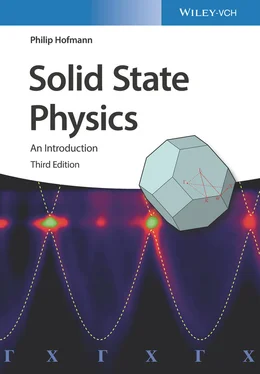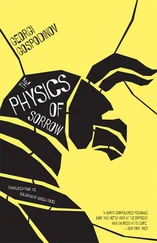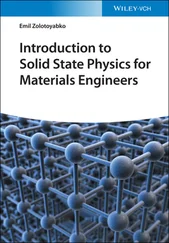Philip Hofmann - Solid State Physics
Здесь есть возможность читать онлайн «Philip Hofmann - Solid State Physics» — ознакомительный отрывок электронной книги совершенно бесплатно, а после прочтения отрывка купить полную версию. В некоторых случаях можно слушать аудио, скачать через торрент в формате fb2 и присутствует краткое содержание. Жанр: unrecognised, на английском языке. Описание произведения, (предисловие) а так же отзывы посетителей доступны на портале библиотеки ЛибКат.
- Название:Solid State Physics
- Автор:
- Жанр:
- Год:неизвестен
- ISBN:нет данных
- Рейтинг книги:4 / 5. Голосов: 1
-
Избранное:Добавить в избранное
- Отзывы:
-
Ваша оценка:
- 80
- 1
- 2
- 3
- 4
- 5
Solid State Physics: краткое содержание, описание и аннотация
Предлагаем к чтению аннотацию, описание, краткое содержание или предисловие (зависит от того, что написал сам автор книги «Solid State Physics»). Если вы не нашли необходимую информацию о книге — напишите в комментариях, мы постараемся отыскать её.
Solid State Physics
Solid State Physics
Solid State Physics
Solid State Physics — читать онлайн ознакомительный отрывок
Ниже представлен текст книги, разбитый по страницам. Система сохранения места последней прочитанной страницы, позволяет с удобством читать онлайн бесплатно книгу «Solid State Physics», без необходимости каждый раз заново искать на чём Вы остановились. Поставьте закладку, и сможете в любой момент перейти на страницу, на которой закончили чтение.
Интервал:
Закладка:
5 Preface to the First Edition Preface to the First Edition This book emerged from a course on solid state physics for third‐year students of physics and nanoscience, but it should also be useful for students of related fields such as chemistry and engineering. The aim is to provide a bachelor‐level survey over the whole field without going into too much detail. With this in mind, a lot of emphasis is put on a didactic presentation and little on stringent mathematical derivations or completeness. For a more in‐depth treatment, the reader is referred to the many excellent advanced solid state physics books. A few are listed in the Appendix. To follow this text, a basic university‐level physics course is required as well as some working knowledge of chemistry, quantum mechanics, and statistical physics. A course in classical electrodynamics is of advantage but not strictly necessary. Some remarks on how to use this book : Every chapter is accompanied by a set of “discussion” questions and problems. The intention of the questions is to give the student a tool for testing his/her understanding of the subject. Some of the questions can only be answered with knowledge of later chapters. These are marked by an asterisk. Some of the problems are more of a challenge in that they are more difficult mathematically or conceptually or both. These problems are also marked by an asterisk. Not all the information necessary for solving the problems is given here. For standard data, for example, the density of gold or the atomic weight of copper, the reader is referred to the excellent resources available on the World Wide Web. Finally, I would like to thank the people who have helped me with many discussions and suggestions. In particular, I would like to mention my colleagues Arne Nylandsted Larsen, Ivan Steensgaard, Maria Fuglsang Jensen, Justin Wells, and many others involved in teaching the course in Aarhus.
6 Preface to the Second Edition Preface to the Second Edition The second edition of this book is slightly enlarged in some subject areas and improved throughout. The enlargement comprises subjects that turned out to be too essential to be missing, even in a basic introduction such as this one. One example is the tight‐binding model for electronic states in solids, which is now added in its simplest form. Other enlargements reflect recent developments in the field that should at least be mentioned in the text and explained on a very basic level, such as graphene and topological insulators. I decided to support the first edition by online material for subjects that were either crucial for the understanding of this text but not familiar to all readers, or not central enough to be included in the book but still of interest. This turned out to be a good concept, and the new edition is therefore supported by an extended number of such notes; they are referred to in the text. The notes can be found on my website www.philiphofmann.net . The didactic presentation has been improved, based on the experience of many people with the first edition. The most severe changes have been made in the chapter on magnetism but minor adjustments have been made throughout the book. In these changes, didactic presentation was given a higher priority than elegance or conformity to standard notation, for example, in the figures on Pauli paramagnetism or band ferromagnetism. Every chapter now contains a “Further Reading” section at the end. Since these sections are supposed to be independent of each other, you will find that the same books are mentioned several times. I thank the many students and instructors who participated in the last few years' Solid State Physics course at Aarhus University, as well as many colleagues for their criticism and suggestions. Special thanks go to NL architects for permitting me to use the flipper‐bridge picture in Figure 11.3, to Justin Wells for suggesting the analogy to the topological insulators, to James Kermode for Figure 3.7, and to Arne Nylandsted Larsen and Antonija Grubišić Čabo for advice on the sections on solar cells and magnetism, respectively.
7 Preface to the Third Edition
8 Physical Constants and Energy Equivalents
9 Begin Reading
10 Appendix A
11 Appendix B
12 Index
13 End User License Agreement
Pages
1 iii
2 iv
3 xi
4 xiii
5 xv
6 xvi
7 xvii
8 1
9 2
10 3
11 4
12 5
13 6
14 7
15 8
16 9
17 10
18 11
19 12
20 13
21 14
22 15
23 16
24 17
25 18
26 19
27 20
28 21
29 22
30 23
31 24
32 25
33 26
34 27
35 28
36 29
37 30
38 31
39 32
40 33
41 34
42 35
43 36
44 37
45 38
46 39
47 40
48 41
49 42
50 43
51 44
52 45
53 46
54 47
55 48
56 49
57 50
58 51
59 52
60 53
61 54
62 55
63 56
64 57
65 58
66 59
67 60
68 61
69 62
70 63
71 64
72 65
73 66
74 67
75 68
76 69
77 70
78 71
79 72
80 73
81 74
82 75
83 76
84 77
85 78
86 79
87 80
88 81
89 82
90 83
91 85
92 86
93 87
94 88
95 89
96 90
97 91
98 92
99 93
100 94
101 95
102 96
103 97
104 99
105 100
106 101
107 102
108 103
109 104
110 105
111 106
112 107
113 108
114 109
115 110
116 111
117 112
118 113
119 114
120 115
121 116
122 117
123 118
124 119
125 120
126 121
127 122
128 123
129 124
130 125
131 126
132 127
133 128
134 129
135 130
136 131
137 132
138 133
139 134
140 135
141 136
142 137
143 138
144 139
145 140
146 141
147 142
148 143
149 145
150 146
151 147
152 148
153 149
154 150
155 151
156 152
157 153
158 154
159 155
160 156
161 157
162 158
163 159
164 160
165 161
166 162
167 163
168 164
169 165
170 166
171 167
172 168
173 169
174 170
175 171
176 172
177 173
178 174
179 175
180 176
181 177
182 178
183 179
184 180
185 181
186 182
187 183
188 184
189 185
190 186
191 187
192 188
193 189
194 190
195 191
196 192
197 193
198 194
199 195
200 196
201 197
202 198
203 199
204 200
205 201
206 202
207 203
208 204
209 205
210 206
211 207
212 208
213 209
214 210
215 211
216 212
217 213
218 214
219 215
220 216
221 217
222 218
223 219
224 221
225 222
226 223
227 224
228 225
229 226
230 227
231 228
232 229
233 230
234 231
235 232
236 233
237 234
238 235
239 236
240 237
241 238
242 239
243 240
244 241
245 242
246 243
247 244
248 245
249 246
250 247
251 249
252 250
253 251
254 252
255 253
256 254
257 255
258 256
259 257
260 258
261 259
262 260
263 261
264 262
265 263
266 265
267 266
268 267
269 268
270 269
Читать дальшеИнтервал:
Закладка:
Похожие книги на «Solid State Physics»
Представляем Вашему вниманию похожие книги на «Solid State Physics» списком для выбора. Мы отобрали схожую по названию и смыслу литературу в надежде предоставить читателям больше вариантов отыскать новые, интересные, ещё непрочитанные произведения.
Обсуждение, отзывы о книге «Solid State Physics» и просто собственные мнения читателей. Оставьте ваши комментарии, напишите, что Вы думаете о произведении, его смысле или главных героях. Укажите что конкретно понравилось, а что нет, и почему Вы так считаете.












